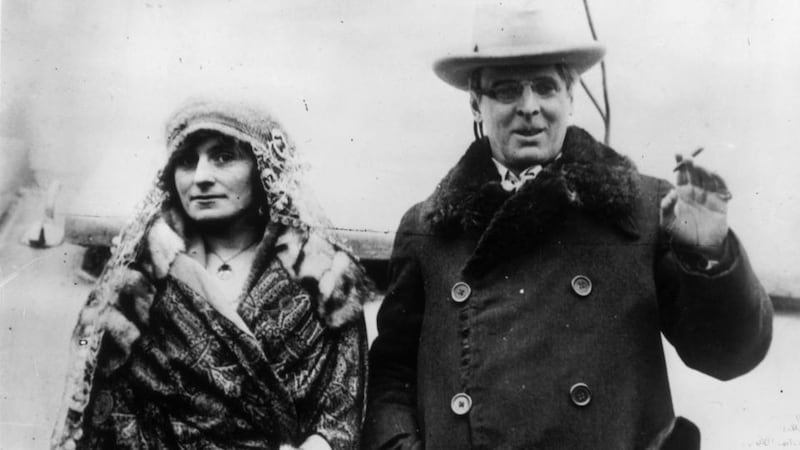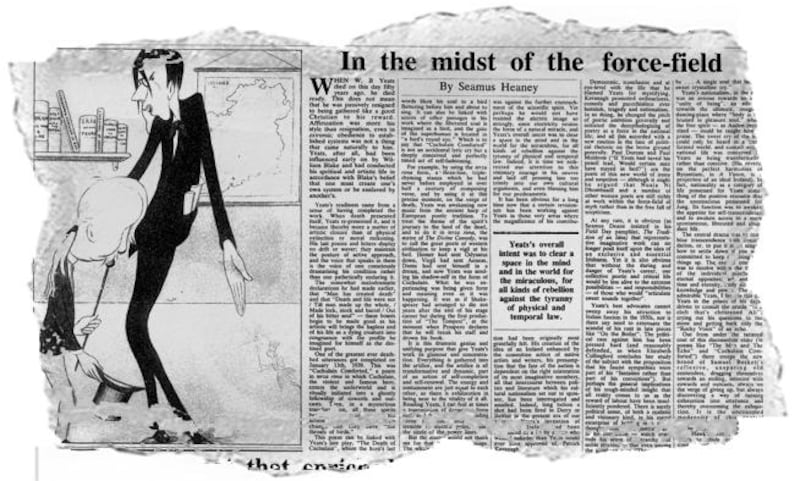William Butler Yeats died 75 years ago today at 2.30pm in a small upstairs room at the Hôtel Idéal Séjour in Roquebrune Cap Martin. The room had a wrought-iron balcony overlooking the Mediterranean, his final vista. Yeats's wife, George, and his last mistress, Edith Shackleton Heald, were at his bedside. They took turns holding vigil over his body that night.
In 1937, Yeats's Irish friends had collected money to make his old age more comfortable. At the dinner where it was presented, Yeats said it would enable him and George to winter in the south of France, where the climate would be more kind to his angina-stricken heart. "My glory was I had such friends," he wrote in The Municipal Gallery Revisited, the poem he penned for the occasion.
Yeats and his wife spent his last two winters at the Idéal Séjour. "It was a simple place," says Oxford professor Roy Foster, author of the two-volume WB Yeats: A Life. "They were watching their pennies."


George handled the train tickets and logistics, after which Heald showed up to keep the ageing poet company. Lady Dorothy Wellesley, to whom Yeats also had a romantic attachment, invited them to dine at her nearby villa, La Bastide.
The winter of 1938-1939 was exceptionally cold, even on the French Riviera, and the freezing temperatures aggravated Yeats’s heart condition. “He disappeared in the dead of winter . . . / What instruments we have agree / The day of his death was a dark cold day,” WH Auden wrote in tribute.
Today, the Idéal Séjour has been rechristened the Résidence le Louisiane, and refurbished with ugly verandas and a swimming pool. For €700-€900, one can rent a two-bedroom apartment there for a week. A simple plaque, placed by the Princess Grace Irish Library in 1995, reads: “William Butler Yeats, Nobel Prize winner, lived and died here, 1938-1939.”
On the night of January 28th-29th, George Yeats gave Heald the manuscript of Are You Content? and The Spirit Medium, poems written on either side of a sheet of paper in the last days of Yeats's life. George also gave Yeats's fountain pen and small Oxford dictionary to Heald.
To Wellesley, George gave the manuscript of Yeats's last play, The Death of Cuchulain, which Yeats completed just before New Year's Day. A week before his death, Wellesley wrote that she "had never seen [Yeats] in better health, wits, charm or vitality". But he took a turn for the worse, and on January 27th George asked Wellesley to "come back and light the flame".
Surrounded by women
Like his alter ego Cuchulain in the play he had just written, Yeats was dying surrounded by women. "These interesting women rallied around him, trying to keep him alive, trying to keep him inspired," recounts Joseph Hassett, author of WB Yeats and the Muses.
Hassett’s book recounts Yeats’s romances with nine women, “and there were others,” he says. “What were these relationships? They were passionate. They had an erotic element. What more does the reader need to know? In them he found creative stimulus.”
“If I die, bury me up there [in the churchyard at Roquebrune],” Yeats told George. “And then in a year’s time, when the newspapers have forgotten me, dig me up and plant me in Sligo.”
Yeats was buried in Roquebrune. But it’s not clear whether George mistakenly committed his body to a pauper’s grave, a five- or a 10-year plot, as she maintained.
Yeats had predicted the second World War years earlier, in The Second Coming. It started the following September, trapping his remains in Roquebrune. According to a 1988 book by Diana Souhami, the section of the cemetery where he was buried was cleared out in 1946, and the bodies dumped in a mass grave. Another version says Italian soldiers disinterred bodies to bury their comrades.
Mistaken identity
Yeats wore a leather truss for a hernia. Alfred Hollis, an Englishman who died in Roquebrune two weeks after Yeats, suffered from tuberculosis of the spine and wore a surgical steel corset. A body wearing some kind of device was exhumed in 1948, on the orders of the French foreign minister. Whether the gravediggers and French officials involved distinguished between a truss and a corset is uncertain, and some believe that Hollis, not Yeats, was sent for burial in Sligo.
A French military guard of honour accompanied the body to Villefranche harbour, where it was loaded on to the Irish naval corvette Macha. George, the Yeats children Michael and Anne, Yeats's brother Jack, and an Irish military guard of honour met the ship at Galway harbour on September 17th, 1948. As minister for external affairs, Seán MacBride, the son of Yeats's great love Maud Gonne, represented the Irish government.
At the funeral, the poet Louis MacNeice allegedly said “You are burying the wrong man.” The remains were placed “Under bare Ben Bulben’s head/In Drumcliff churchyard” as Yeats requested in the poem he wrote in Roquebrune shortly before his death. Yeats’s son Michael insisted the bones were measured, and that they matched WB’s large body structure. The academic Ann Saddlemyer, a close friend of George Yeats, examined the French documents and concluded it was Yeats’s body that was exhumed.
The question was so painful for the Yeats and Hollis families that they decided to drop the issue. A DNA test is unlikely. "These kinds of controversies come and go about all shrines," says Prof Warwick Gould of the Department of English, University of London, evoking "bard-olatry" and past moves to dig up Shakespeare at Stratford-upon-Avon. Yeats, Gould says, was "the greatest poet since Shakespeare". He sees the controversy as a sign of Yeats's "cult status", and notes that "nobody doubts Yeats wrote the poems".
Yeats is one of the rare Nobel laureates to have written much of his best work after winning the prize, in his case in 1923. As Yeat’s body failed him, he wrote “with such extraordinary energy and radicalism”, says Prof Foster.
"His creative surge, which goes back to the early 1930s, carried through until his death. Those poems of the 1930s are some of the most exciting things he ever wrote, poems such as Lapis Lazuli, The Circus Animals' Desertion and Long-Legged Fly are extraordinary achievements, and they came at the end of his writing career. The sense of mortality he has infuses them with a kind of grandeur and a tragic sense. But the importance of gaiety in the face of death is a constant theme in the late work."
Yeats believed virility was an integral part of his poetic gift. Five years before his death, London surgeon Norman Haire performed the “Steinach operation”, a partial vasectomy, to restore his potency. Haire indiscreetly told Yeats’s biographer Richard Ellmann that the operation failed, but Yeats thought it worked. He traced “the ferment that has come upon my imagination” to “the strange second puberty the operation has given me”.
Two years before his death, Yeats wrote in his autobiography that a poet “is never the bundle of accident and incoherence that sits down to breakfast; he has been reborn as an idea, something intended, complete”.
Heaney's tribute
By writing almost to the moment of his death, Yeats seemed to embody the notion of the poet's intended life. "He died ready," Seamus Heaney wrote in this newspaper on January 28th, 1989, in an article marking the 50th anniversary of Yeats's death. The poet's passing was "more a matter of artistic closure than of physical extinction or moral reckoning", Heaney added.
"Reading Yeats, I can feel at times a transmission of dangerous force such as I felt as a child, standing alone in fields close to the tremble of electric poles, under the sizzle of the power lines," wrote Heaney. He called Cuchulain Comforted, the poem Yeats completed 15 days before his death, "one of the greatest ever death-bed utterances".
For the first time in his life, Yeats wrote in terza rima, the difficult metre used by Dante in The Divine Comedy. The poem was the literary equivalent of live-blogging. "What he was experiencing was being given form and meaning even as it was happening," Heaney wrote.
By chance, Heaney's friend Joseph Brodsky died on January 28th, 1996. In Audenesque, a poem commemorating Brodsky's passing, Heaney wrote, "Therefore, Joseph, on this day / Yeats's anniversary / (Double-crossed and death-marched date / January twenty-eighth)".
Auden wrote of Yeats, “You were silly like us; your gift survived it all”, mocking what he called “the California side” of the poet.
Paula Meehan, the current Ireland Professor of Poetry, regrets that Yeats's interest in tarot cards, automatic writing, seances and the occult has long been ignored.
“As I grow older, I look more and more to the dreamer in Yeats,” says Meehan, “the man who trusted intuition. His entire gift was predicated on the dream within him, from his first powerful encounter in Howth as a teenager, when he listened to the heartbeat of the Great Mother. We need that kind of nature rapture now.”
Although Ireland's two great poets were very different, comparison is inevitable. "I cannot help thinking of Seamus Heaney when I think of Yeats's death," says Terence Brown, emeritus fellow of Trinity College Dublin. "Both were truly national figures who made of their deep involvement in the places they came from – whether Sligo or Bellaghy in Derry – the stuff of poetry that speaks to the world. They brought great honour on Ireland. Yeats lived through and wrote about the civil war. Heaney lived through and wrote about the Troubles. Both showed how poetry enables, helps us to comprehend and survive."












